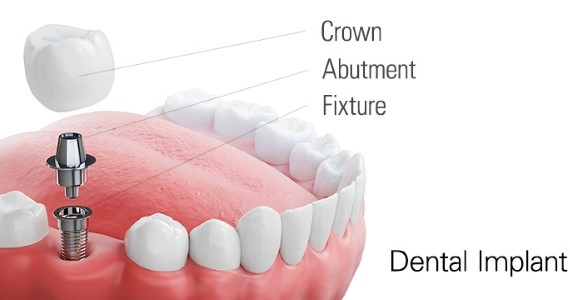A deep dive on dental implant surgery
Take a look at this multi-step dental implant procedure.

A dental implant is a metal post that is surgically inserted into the bone to support an artificial tooth. Depending on the condition of the mouth, treatment may span several months or years.
Dental implants may be used to support:
- Single tooth replacement
- Fixed dentures or bridges
- Removable dentures or partial dentures
The ideal dental implant candidate should have healthy gums that are free of periodontal disease (gum disease).
Alternate benefit information
It's important to speak with your dentist about your options before you receive implant treatment. An implant is covered by BCBS FEP Dental only if determined to be dentally necessary and the least expensive appropriate treatment. Implant services may be reviewed for benefit determination and dental necessity. Review is conducted by our licensed dentists.
Your dentist may need to provide supporting clinical documentation, such as chart notes and X-rays, for the review. Please note: if our licensed dentist determines that a less expensive appropriate treatment is available, no benefits will be allowed for the implant(s) or their related procedures. This means the allowance for the less expensive treatment may be approved. This alternation of benefits may allow for some reimbursement rather than a denial (which would provide no reimbursement).
Pretreatment estimate
Prior to any implant services, it is critical for your dentist to submit a pretreatment estimate to BCBS FEP Dental. This should include a comprehensive treatment plan and necessary supporting documentation, including chart notes, radiographic images and photos. BCBS FEP Dental will provide a non-binding Explanation of Benefits (EOB) to both you and your dentist that will indicate if procedures are covered and an estimate of what we will pay for those specific services. The estimated plan allowance is based on your current eligibility and benefits in effect at the time of the pretreatment estimate. Submission of other claims or changes in eligibility or benefits may alter final payment. Keep in mind, a pretreatment estimate is not a guarantee of benefits.
Placing the dental implant
The process of placing a dental implant starts with your dentist making a cut to open your gum and expose the bone. Next, they drill into the bone and insert a screwlike post. This post functions like a tooth root, so it's implanted deep into the bone for stability.
After this procedure, your jawbone needs time to heal and fuse with the dental implant in a process called osseointegration. This can take several months, but it is critical in forming a solid base for any dental restoration. During this period, the gap where your tooth is missing will still be present. In some cases, your dentist may provide you with a removable temporary denture for appearance reasons.
Placing the abutment
After completing osseointegration, your dentist will install the component used to attach the crown, called the abutment. This minor procedure is typically completed with local anesthesia. Your dentist will allow around two weeks for your gums to heal around the abutment before attaching your artificial tooth.
Sometimes, the abutment is attached to the implant post when the post is surgically placed. These cases don't require the extra surgical step.






